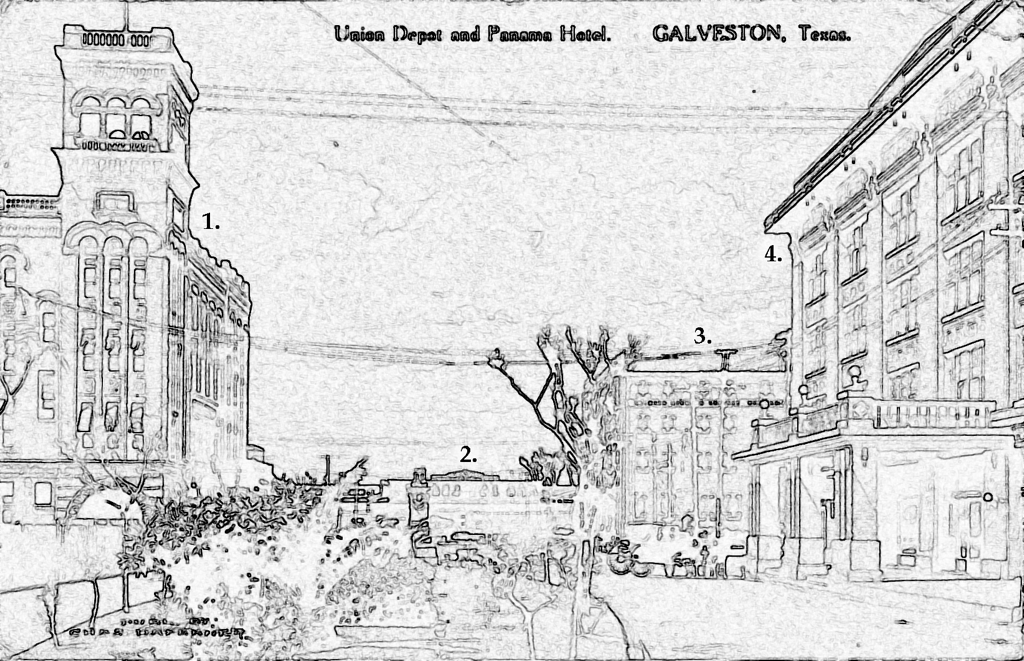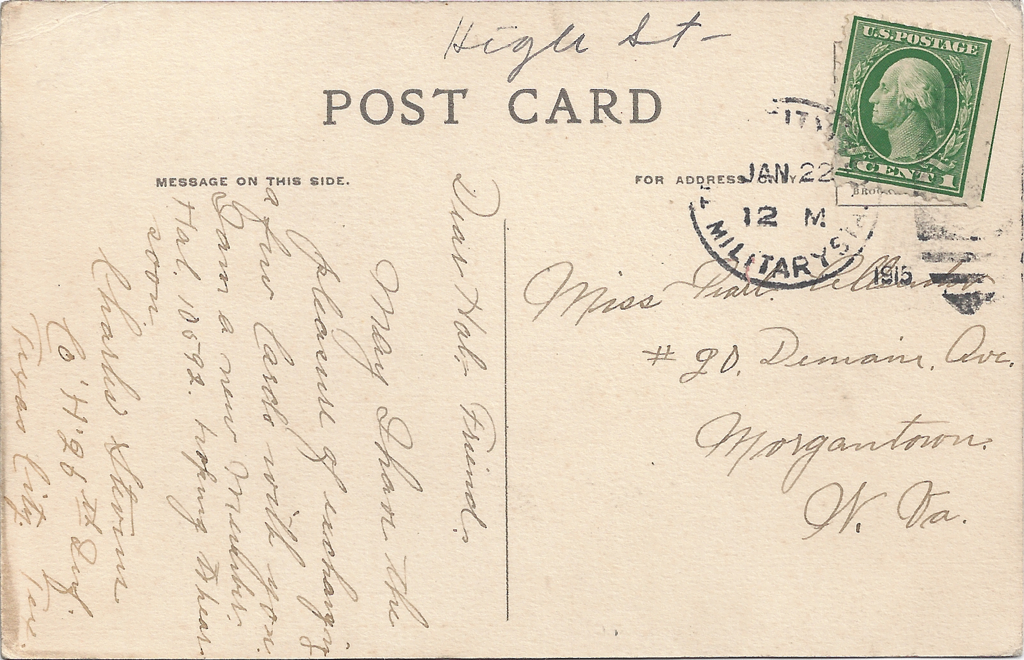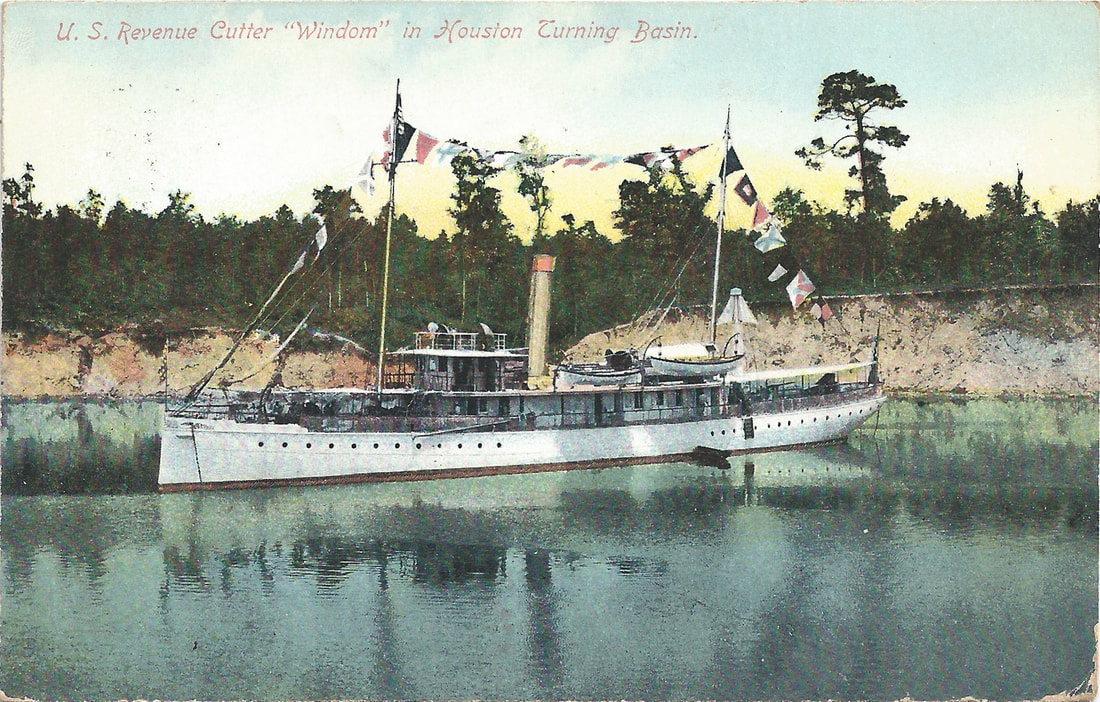Union Station - Panama Hotel
|
22 January 1915: 1. 119 Rosenberg (25th): Union Station, 4 floors plus a two story crenelated tower in the Victorian Romanesque style, 1897;
2. Pier 25 Wharves; 3. 2415-2425 Water Street (Avenue A, now Harborside): Ullman, Stern & Krausse Wholesale Grocers, proprietors Moses Ullmann (1844-1929), Morris Stern (1864-1944), Charles August Julius “Chief” Krausse (1867-1927), 4 stories, built after the 1900 storm; 4. 204 Rosenberg (25th): Panama Hotel, 4 floors, 1913 designed by Houston architects Lewis Sterling Green and Joseph Finger. |
24 March 2019: 1. 123 Rosenberg (25th): Shearn Moody Plaza, (formerly the Santa Fe Building), an imposing Art Deco structure grounding the Strand District, offset at the terminus of Avenue B or Strand and Rosenberg (25th), 11 floors, 1932 to replace the 1897 Union Station and join the 1913 Santa Fe Annex; 2. 2502 Harborside: Cruise Ship at Pier 25 Cruise Terminal Building built in 1927, 2 stories; 3. 2424 Strand (Avenue B): Galveston Transit Terminal, built on the site of a former automobile service station and the parking lot for the Santa Fe Building (later the Shearn Moody Parking Garage); 4. 202 Rosenberg (25th): Panama Lofts renovated from the Panama Hotel.
|
|
Postmarked: 22 January 1915; Te[xas C]ity Military Station;
To: Miss Pearl. Allender #20. Demain. Ave. Morgantown. W. Va. Message: Dear Hal. Friend. May I have the pleasure of exchanging a few Cards with you. I am a new member Hal. 10592 hoping to hear soon. Charles Stevens Co ‘H’ 26th Inf. Texas City. Tex. Charles Stevens was reaching out to Pearl Allender as he was stationed at Texas City in the midst of America’s reactions to the troubles at the Mexican Border. The Mexican Revolution was in full swing south of the border after its start in 1911, and refugees, including some key revolutionaries, found safe harbor by crossing the Rio Grande. Politicians in the U.S. appraised an independent Mexico as a possible threat to stability, and were unsure of the new nation’s international alliances at a time when many feared a European war might spring up at any time. In 1913 US President William Howard Taft moved to increase the number of soldiers who could rapidly deploy to the border by establishing a camp for 10,000 soldiers at Texas City. Located on the mainland just north of Galveston, the town had only been incorporated two years before, and city organizers successfully lobbied to have the installation situated adjacent to the town. The port of Galveston’s Fort Crockett was a well-established staging facility, but could not hold such a large encampment, so the closest available site was where the Galveston causeway connected to the mainland. Once the camp began to fill, however, it became evident that Texas City was a poor location for the thousands of tents erected on the flat plain adjacent to Galveston Bay. Partly marshland at no more than 10 feet above sea level, it was oppressively hot in the summer, plagued by mosquitos and the diseases they carry, and under continual threat from disastrous storms. Texas City itself had a population of less than 2,000 so civilians were vastly outnumbered by the soldiers encamped there, but naturally the military presence brought a boom in business and an increase in population. Just seven months after Charles wrote the postcard, the area was hit by the largest hurricane to reach landfall since the disastrous 1900 storm that nearly destroyed Galveston. This storm completely destroyed the encampment and caused 9 deaths among the soldiers, and shortly afterwards the 2nd Division was moved to San Antonio, TX.
Soldiers in these camps were thrown together from across America, and diversions to combat boredom were few and far between. One such distraction was found in postcard exchange clubs. Volunteer soldiers recently uprooted from their origins had been given a new vision of their nation, and were eager to catch a glimpse of parts of the country they might never visit, but for which they were sacrificing their freedom to protect. Many postcard exchange clubs published newsletters, and upon subscription, sent out vetted lists of other interested collectors. These clubs are now largely lost to history and the origins and fate of HAL to which Charles Stevens turned for stimulation is unknown, even as to in what part of the country it began. [Refer to discussion in next column]
Although Charles Stevens of the postcard and Clarence Charles Stevens from Indianapolis are not provably identical, compelling corroboration can be found in the close signature matches between the postcard and those on the WWI and WWII draft registrations. When Clarence Stevens enlisted, he might have used his father Charles’ name (his own middle name) as some kind of tribute and kept it through his service as it would have become his ID for mail. When he saw Pearl Allender’s name on the HAL postcard exchange club, he may have been drawn to it because it was his sister’s name. If the hypothesis is that Charles Stevens is identical to Clarence Stevens, there is a risk of a Type II Error, accepting a false hypothesis. If the surname Stevens were an unusual one, the population of candidates for his identity might be small, and the risk lower. The Stevens surname is unfortunately rather common and there are probably hundreds and maybe thousands of soldiers who might qualify across the 48 states. Among that large number a few could fit the criteria just by random chance. Since the signature matches above are not strong, and perhaps even inconsistent, the confidence might not even rise to 50%, perhaps even lower. Therefore this Clarence Stevens might be thought of as an exemplar of a type of soldier who might have been at Texas City in 1915. |
Mary Pearl Allender was twenty years old when she received the card, and whether she reciprocated is lost to history. She was then the last of the children living with her parents Elisha C. Allender and his second wife Emma R. Kelley at #20 Demain Avenue in Morgantown, WV. The town of about 10,000 was situated on the Monongahela River about 75 miles south of its confluence with the Allegheny River in Pittsburgh, PA where the two streams combined to form the origin of the Ohio River. Elisha was a machinist at a tin mill, and he had two children by his first wife Abigail Miller: Malinda Maud (1874) and Linnie (1875); he also had three children from Pearl’s mother: Harry C. (1882), Elisha A. (1883), and Mary Pearl (1885).
Pearl remained single until she was about 23 when she married Benjamin Harrison Cavalier in New Jersey. What drew them there is unknown, since neither lived in that state, nor is it clear how they became acquainted. Benjamin was the son of Silas Alfred Cavalier, a physician in Harrison County, WV about 40 miles southwest of Morgantown. Benjamin volunteered for the military in the summer of 1909 in Kansas, and by 1910 he was stationed near Tampa, FL. In 1915 he served at Gull Island in Fort Michie established to protect maritime traffic in Long Island Sound. This may have been a claustrophobic post since the tiny island was entirely covered with buildings, but it was also a birder’s paradise isolated from the clamor of the continent. Benjamin went on to serve in WWI after they married, and upon return, settled in the Allender home on Demain Avenue in Morgantown where he worked various jobs such as tool driver at an oil mill (1920), salesman (1929, 1940), and she worked various clerical jobs, such as bookkeeper for a Savings and Loan company (1929). When WWII came both found work for the Federal Government, Benjamin for the ships locks on the Ohio river in Hancock County in the panhandle of West Virginia some 70 miles northwest of Morgantown and Pearl worked for a WPA educational project. They had no children, and some time after 1951 they separated and Benjamin became the 6th husband of Ollie Naomi Centers in 1958. Benjamin and Ollie married in Bristow, OK about 35 miles southwest of Tulsa, but 8 years later she died in Cleveland, Pawnee County, OK west of Tulsa. Benjamin died in 1973 at Sedalia, MO and is buried there in Crown Hill Cemetery. He may have moved to Missouri to be near the family of his older brother, physician John Paul Cavalier (1877-1941), who settled in Cabool, Texas County in south central Missouri in about 1900. His nephew Sam Cavalier (1916-2002) is also buried in Crown Hill Cemetery as well his niece Maxine Roberts Cavalier Watson (1919-2005). Pearl did not remarry and remained in Morgantown until her death in 1978. She was buried in Oak Grove Cemetery there, joining her father Elisha C. Allender (1845-1924) and sister Maud A. Patterson (1875-1969). Charles Stevens reveals his military assignment on the postcard and little else, so with easily accessible records he cannot be identified with precision. A focused search through records at the National Archives is beyond the scope of this inquiry, but might be brought to bear to find out with certainty who he was. In the interim, one individual has been found who might serve at least as a tentative ID awaiting confirmation, or conversely, a hypothesis rejected. Like Cavalier, he volunteered for service in the lacuna between the Spanish War of 1898 and the World War, thus placing himself in a smaller subset of records to peruse, so possibly a little easier to find. Clarence Charles Stevens of Indianapolis, IN volunteered 19 December 1914 for a three year tour of service at the age of 25. He was six years married at the time, with a six year old son who was born the day before his marriage to Minnie Roembke on 8 October 1908. He seems to have been somewhat of a reluctant husband, and perhaps not tightly tethered to his family at the time of his enlistment. His military assignment cannot be ascertained at this time in order to see if he was ever in Texas City, but his obligation should have been completed on 19 December 1917. He apparently returned home early, and when he registered for the WWI draft on 5 June 1917 he listed his previous three year tour of military service and was not brought into the great conflict. His parents were Charles Stevens (1859-1900) and Sarah Andrews (1863-1929, daughter of William Andrews and Sarah Webb) whose only children were Clarence and Mabel Pearl Stevens (1883-1948). His sister may have suggested a military enlistment as she herself enlisted in 1904 and served about a year. Pearl married Thomas Otto Lanpher 24 September 1908 just 2 weeks before Clarence’s marriage. Clarence’s wife Minnie was the daughter of Frederick Roembke (1858-1943), and their son Charles Frederick Stevens bore his grandfather’s name. The families of Minnie and Clarence Stevens and Otto and Pearl Lanpher remained close throughout most of their lives. The family off came to reside in adjacent homes at 1304 and 1306 Olive Street in Indianapolis. Clarence and Pearl apparently grew up in the Stevens home at 1304 Olive, and when Clarence returned from his service to Indianapolis in 1917, Sarah, Otto and Pearl had moved to next door to 1306 Olive and Clarence found a home at 839 Woodlawn about 10 blocks from his mother and sister. Clarence remained at Woodlawn through 1920, and after Sarah died in 1929, the families were adjacent with Clarence renting at 1306 ($25 per month!) and Otto owning 1304 ($5000) (in 1930). Otto moved to 845 Drexel about 5 miles away by 1935 as Clarence took ownership at 1306 ($1700). [The house at 1306 was built in 1880 and is still extant more than 140 years later, but 1304 has been demolished and was replaced in 2020.] Clarence worked at various jobs, first involving metalwork, stove fitter (1909), sheet metal assembler (1910-1912), then grocery truck driver (1920) and finally Ford automobile mechanic (1930-1940). Otto worked similarly in blue collar occupations, machinist (1909), a clerk for Crescent Paper Company (1912), garage machinist (1920), and auto mechanic (1930, 1940). Clarence died at 1306 Olive Street in 1963 and is buried in Concordia Cemetery in Indianapolis. Minnie died in 1969 and is buried beside her husband. His parents Charles and Sarah Stevens are buried in park-like Crown Hill Cemetery in Indianapolis, third largest cemetery in America with 211,613 interments amid a luxurious park-like environment. Clarence’s son Charles Frederick Stevens moved to Van Wert County, Ohio, then California. He died in 1971 and is buried in Westminister Memorial Park in Orange County, CA. His wife Clara Virginia Gabard Stevens (1913-2017) died at age 104 and is buried in Concordia Cemetery. Also in Concordia Cemetery is Minnie’s father Frederick Roembke (1858-1943) and mother Emma S. Boehning Roembke (1864-1948). |








